The 2011 Mid-Range SSD Roundup: 120GB Agility 3, Intel 510 and More Compared
by Anand Lal Shimpi on June 7, 2011 12:52 PM ESTAnandTech Storage Bench 2011
I didn't expect to have to debut this so soon, but I've been working on updated benchmarks for 2011. Last year we introduced our AnandTech Storage Bench, a suite of benchmarks that took traces of real OS/application usage and played them back in a repeatable manner. I assembled the traces myself out of frustration with the majority of what we have today in terms of SSD benchmarks.
Although the AnandTech Storage Bench tests did a good job of characterizing SSD performance, they weren't stressful enough. All of the tests performed less than 10GB of reads/writes and typically involved only 4GB of writes specifically. That's not even enough exceed the spare area on most SSDs. Most canned SSD benchmarks don't even come close to writing a single gigabyte of data, but that doesn't mean that simply writing 4GB is acceptable.
Originally I kept the benchmarks short enough that they wouldn't be a burden to run (~30 minutes) but long enough that they were representative of what a power user might do with their system.
Not too long ago I tweeted that I had created what I referred to as the Mother of All SSD Benchmarks (MOASB). Rather than only writing 4GB of data to the drive, this benchmark writes 106.32GB. It's the load you'd put on a drive after nearly two weeks of constant usage. And it takes a *long* time to run.
I'll be sharing the full details of the benchmark in some upcoming SSD articles but here are some details:
1) The MOASB, officially called AnandTech Storage Bench 2011 - Heavy Workload, mainly focuses on the times when your I/O activity is the highest. There is a lot of downloading and application installing that happens during the course of this test. My thinking was that it's during application installs, file copies, downloading and multitasking with all of this that you can really notice performance differences between drives.
2) I tried to cover as many bases as possible with the software I incorporated into this test. There's a lot of photo editing in Photoshop, HTML editing in Dreamweaver, web browsing, game playing/level loading (Starcraft II & WoW are both a part of the test) as well as general use stuff (application installing, virus scanning). I included a large amount of email downloading, document creation and editing as well. To top it all off I even use Visual Studio 2008 to build Chromium during the test.
Update: As promised, some more details about our Heavy Workload for 2011.
The test has 2,168,893 read operations and 1,783,447 write operations. The IO breakdown is as follows:
| AnandTech Storage Bench 2011 - Heavy Workload IO Breakdown | ||||
| IO Size | % of Total | |||
| 4KB | 28% | |||
| 16KB | 10% | |||
| 32KB | 10% | |||
| 64KB | 4% | |||
Only 42% of all operations are sequential, the rest range from pseudo to fully random (with most falling in the pseudo-random category). Average queue depth is 4.625 IOs, with 59% of operations taking place in an IO queue of 1.
Many of you have asked for a better way to really characterize performance. Simply looking at IOPS doesn't really say much. As a result I'm going to be presenting Storage Bench 2011 data in a slightly different way. We'll have performance represented as Average MB/s, with higher numbers being better. At the same time I'll be reporting how long the SSD was busy while running this test. These disk busy graphs will show you exactly how much time was shaved off by using a faster drive vs. a slower one during the course of this test. Finally, I will also break out performance into reads, writes and combined. The reason I do this is to help balance out the fact that this test is unusually write intensive, which can often hide the benefits of a drive with good read performance.
There's also a new light workload for 2011. This is a far more reasonable, typical every day use case benchmark. Lots of web browsing, photo editing (but with a greater focus on photo consumption), video playback as well as some application installs and gaming. This test isn't nearly as write intensive as the MOASB but it's still multiple times more write intensive than what we were running last year.
As always I don't believe that these two benchmarks alone are enough to characterize the performance of a drive, but hopefully along with the rest of our tests they will help provide a better idea.
The testbed for Storage Bench 2011 has changed as well. We're now using a Sandy Bridge platform with full 6Gbps support for these tests. All of the older tests are still run on our X58 platform.
AnandTech Storage Bench 2011 - Heavy Workload
We'll start out by looking at average data rate throughout our new heavy workload test:
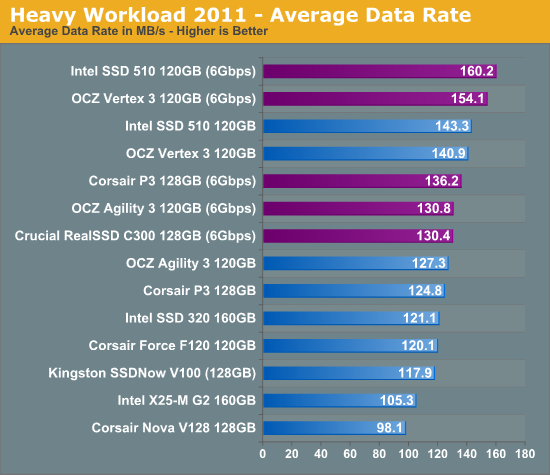
What SandForce has done with the SF-2281 controller is very impressive when you look at these results. Keep in mind that our Heavy Workload is the most write-heavy of our new benchmarks and it uses a lot of data that's already compressed (images, videos, file archives). Despite the makeup of the workload, the SF-2281 based Vertex 3 is nearly the fastest drive here - outpacing both the P3 and C300. The Agility 3, with its asynchronous NAND isn't quite as strong and is actually outpaced by Corsair's P3.
Intel's 160GB SSD 320 is a 3Gbps SATA drive and thus it can't compete with the 6Gbps offerings near the top. If we only look at 3Gbps results however, the standings aren't all that impressive. The 320, P3 and Agility 3 all fall within the same performance group, with the Vertex 3 clearly pulling ahead.
There's another drive from Intel however that does manage to impress: the Intel SSD 510. At 250GB, the 510 isn't competitive with OCZ's 240GB Vertex 3 however at 120GB the tests tell a different story. OCZ loses the ability to interleave reads/writes on a per device basis and thus takes a pretty significant performance hit. It's likely all of the incompressible data in this workload that really forces a difference between the 240GB and 120GB Vertex 3s. The 510 however doesn't have that problem, and the 120GB drive actually outperforms the Vertex 3 here. Not to mention that it should be more reliable if history is any indication.
The breakdown of reads vs. writes tells us more of what's going on:
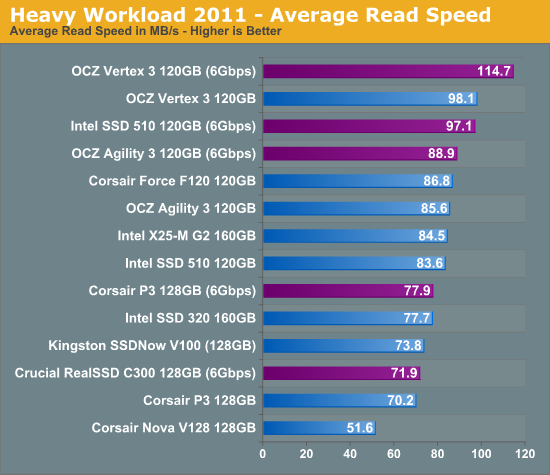
Read performance is where the Vertex 3 really makes up most of its advantage. At 114.7MB/s the Vertex 3 is nearly 30% faster than the Agility 3 here. Write speed however is a closer race between all of the drives:
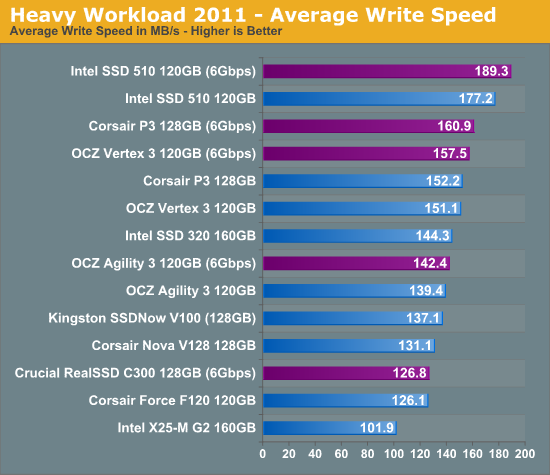
The next three charts just represent the same data, but in a different manner. Instead of looking at average data rate, we're looking at how long the disk was busy for during this entire test. Note that disk busy time excludes any and all idles, this is just how long the SSD was busy doing something:
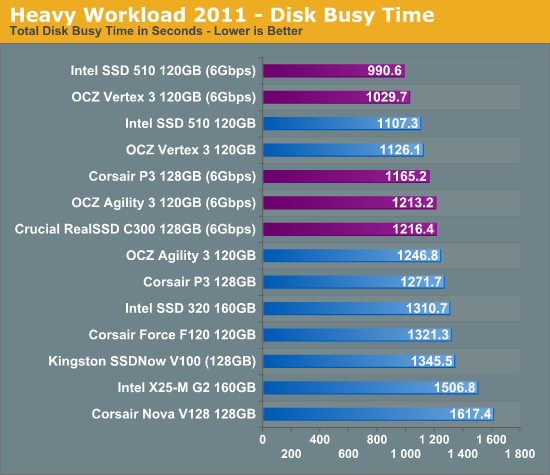
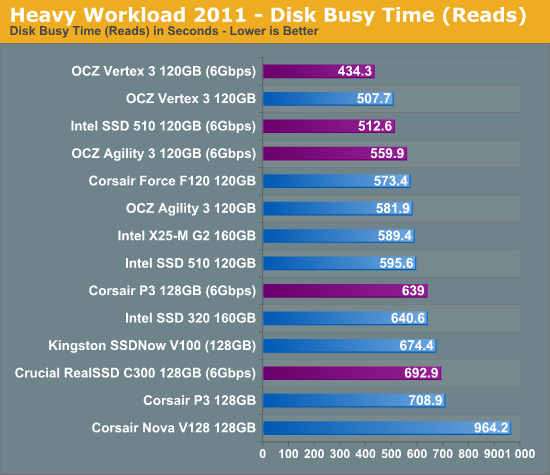











68 Comments
View All Comments
voidi - Wednesday, June 8, 2011 - link
I've been waiting for an article like this for a long time. I think there are more people interested in the middle-class, 120GB SSDs, because everything above that capacity is still very expensive, and 120GBs should prove sufficient for most users to store the OS + a load of programs + all games you currently play from time to time. Twice the space is always nice, of course, but I don't feel it's necessary.Thank you so much for this review!
voidi - Wednesday, June 8, 2011 - link
By the way, in Europe, the Agility 3 120GB is currently ~180 € with shipping, whereas the Vertex 3 120GB goes for ~215 €. Interesting to see that the pricing is so different in the US, even in favor of the Vertex sometimes.voidi - Wednesday, June 8, 2011 - link
I just realized you corrected that already, nevermind :)wvh - Wednesday, June 8, 2011 - link
Thanks for the article. It seems there really isn't a bad choice amongst those options, depending on one's priorities.Anand, could you do a short section on encryption in the next article? There are lots of manufacturers who claim their products support encryption, but there's a lot of conflicting information out there and it would be good to know which drives – if any – offer reliable encryption from a data security point of view, and how they provide this security (ATA boot? TPM?).
jensend - Wednesday, June 8, 2011 - link
I was among those clamoring for this a while back, and would like to thank you for doing this review. Hopefully comparative reviews of lower-than-highest-capacity SSDs will become commonplace throughout the tech world moving forward.anotherengineer - Wednesday, June 8, 2011 - link
Great review Anand. However on the first page with the SSD comparison table, how come you didn't include the firmware version that was used for the testing?Thanks
sean.crees - Thursday, June 9, 2011 - link
First, i didn't see the F120 in the price graph in the beginning, but noticed it in the benchmarks.On a 3gb controller, its performance is very competative, and the power consumption is among the best available.
Then i went to newegg to check the price. $215 for the 120g is a lot less than anything else in this round-up. Thats only $179 per GB. So it is simultaniously the best total price, and best price per GB. With the top 3 best performance on a 3gb controller, and the best power consumption.
How is the F120 not highly recommended in this review?
The one thing that i think Anand forgets is that 3gb controllers are still more common, especially if your using an SSD to upgrade an existing laptop/desktop computer.
JasonInofuentes - Thursday, June 9, 2011 - link
Not sure if this is specifically why Anand didn't include it, but part of the trouble with reviewing tech hardware is that it's always unclear just how long a piece of technology will stay not just relevant but available. Is the Corsair a competitive drive in the SATA II space? You bet, I actually was thinking of putting one to use in my system. Is it pretty available on sites like NewEgg? Yeah, but for how long. It's an older drive at this point and the amount of time it stays on the market is unknown. Better to tell you, and the guy that checks this article out in August after he's earned some cash over the summer for a new build, what is the best drive that WILL be available in a few months, and likely for a while after that.What I think everyone is really itching for is the $/GB to fall steeply thanks to the move to 25 nm NAND. The era of $1/GB SSDs are probably still some ways off, but I would hope that we could enjoy a drift towards $1.5/GB before 19 nm NAND hits the streets.
Jason
superccs - Thursday, June 9, 2011 - link
Every time I come here I see you look at performance on multiple platforms, which makes sense , but lately it seems that it is Intel board X and Intel board Y. How hard is it to find a 890 board and throw some new toy in it?There are quite a few peeps out there who use AMD hardware so throw us a bone damnit.
.
Mitch101 - Thursday, June 9, 2011 - link
What we need now is a reliability report. I know of several people (3) with SSD drives and all have experienced a drive failure and these are desktops not servers, no defrag, with virtual swap files. Speed is great but if I have to replace the drive every 6-9 months because of failure Im staying away.